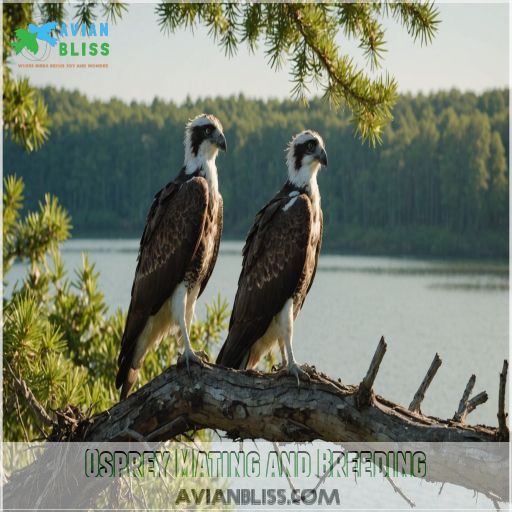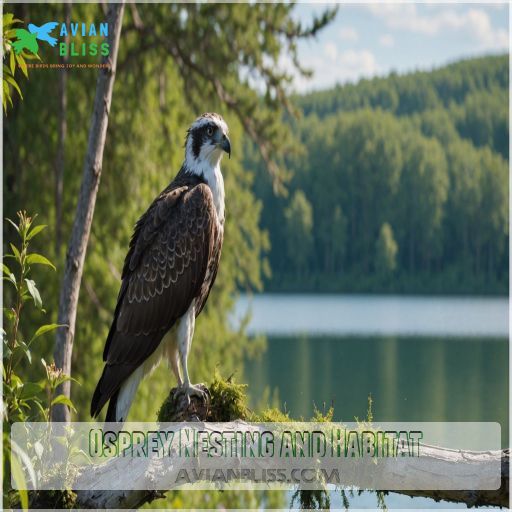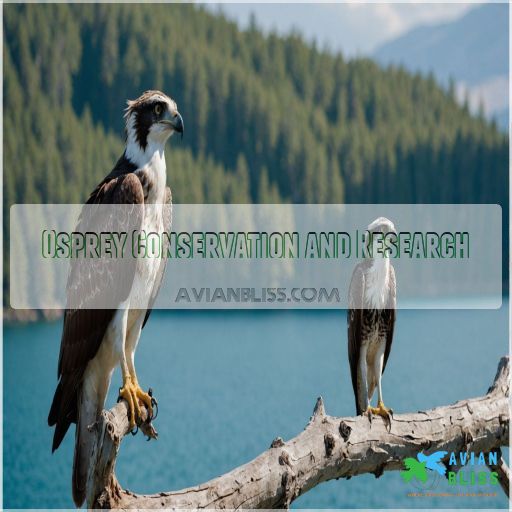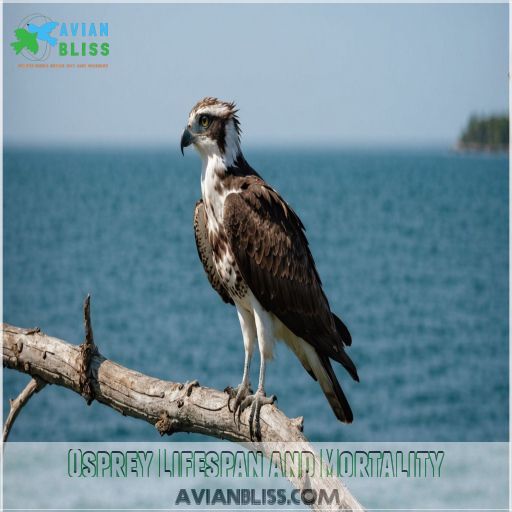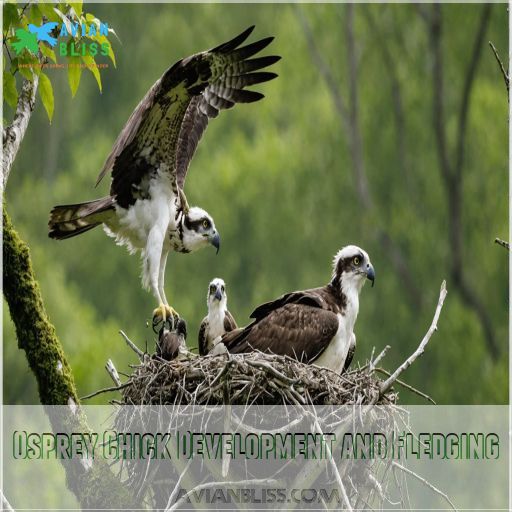This site is supported by our readers. We may earn a commission, at no cost to you, if you purchase through links.
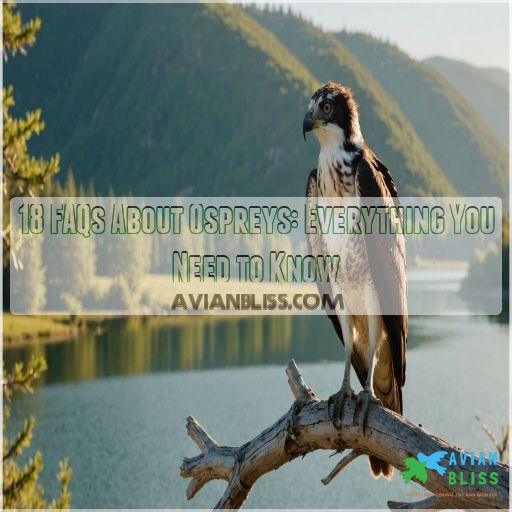
Ospreys are expert fish hunters, boasting a diet that’s almost exclusively aquatic.
They build their nests high and near water, using sticks and grass for construction—imagine a cozy basket on stilts!
With lifelong pair bonds, they share parenting duties, making sure their chicks are safe and sound.
These migratory marvels clock impressive miles each year, zipping between continents.
Despite facing challenges like mercury pollution, ospreys are resilient.
Ready to dive (oops!) deeper into their world? Let’s take flight and explore more!
Table Of Contents
- Key Takeaways
- Osprey Mating and Breeding
- Osprey Nesting and Habitat
- Osprey Diet and Foraging
- Osprey Migration and Distribution
- Osprey Nesting and Egg-Laying
- Osprey Conservation and Research
- Osprey Behavioral Adaptations
- Osprey Lifespan and Mortality
- Osprey Chick Development and Fledging
- Osprey Interactions and Conflicts
- Frequently Asked Questions (FAQs)
- Do ospreys use the same nest every year?
- Do ospreys have extra-pair copulations?
- Why are Osprey coming back?
- Is Osprey a problem?
- What are some cool facts about ospreys?
- What keeps ospreys away?
- How many years do ospreys live?
- How aggressive are ospreys?
- What are the ospreys vocalization patterns?
- How do ospreys impact local ecosystems?
- What are the osprey’s key physical characteristics?
- How do ospreys interact with human environments?
- What are common threats ospreys face daily?
- Conclusion
Key Takeaways
- Ospreys are Fish Fanatics: These birds are like sushi lovers with wings, sticking almost exclusively to a fish diet. Their sharp vision and nifty talons make them the ultimate anglers of the sky, grabbing their slippery prey with ease.
- Nesting in Style: Ospreys are the real estate moguls of the bird world, often returning to the same nest year after year. They build their homes high up, like penthouses with a view, using a mix of sticks and grass to create a fortress that keeps predators at bay.
- Migration Marvels: Think of ospreys as the marathon runners of the bird kingdom. They embark on epic journeys, traveling solo across continents to escape the winter blues and find sunnier skies. Watching them is like witnessing nature’s version of a globe-trotting adventure.
- Faithful… Mostly: Although known for their lifelong pair bonds—think of them as the high school sweethearts of the bird world—ospreys sprinkle in a bit of drama with occasional flings. This adds a twist to their story, helping to boost genetic diversity in their offspring.
Osprey Mating and Breeding
Ever wondered what makes osprey relationships tick? These fascinating birds mate for life, showcasing monogamous loyalty but with a twist—occasional extra-pair flings.
Osprey Mating for Life
Ever wonder about osprey fidelity? These remarkable birds typically form lifelong pair bonds, akin to high school sweethearts reunited each spring with a slap of wings in a skyward dance. While more about nest location than romantic gestures, their breeding success and courtship rituals are heartwarming.
- Pair Bonds: Strong and enduring
- Nest Loyalty: Key to relationship
- Courtship Rituals: Sky dances and calls
- Breeding Success: Collaboration in parenting
- Widespread in North America: Adaptable residents .
Monogamy and Extra-Pair Copulations
Ospreys famously mate for life, yet there’s a twist!
While they’re mainly monogamous, extra-pair copulations can occur, adding a splash of unpredictability.
This sneaky strategy might enhance genetic diversity among offspring.
Imagine ospreys whispering "it’s complicated" on Facebook!
Despite these occasional flings, their commitment to parental care and overall reproductive success remains strong, keeping family bonds flying high .
Courtship Behaviors and Displays
During courtship, male ospreys put on an impressive aerial display, soaring high above the nest and then dramatically plunging down, only to swoop back up again.
This "sky dance" showcases the male’s hunting prowess as he carries a fish in his talons, hoping to impress a potential mate.
Frequency of Copulations
Ospreys are known for their passionate relationships!
With copulation frequency driven by their strong pair bond, they help create a thriving nest during the mating season.
Though they’re typically monogamous, don’t be surprised by occasional extra-pair copulations.
- Mating peaks shortly before egg-laying.
- Successful copulation observed up to five times daily.
- Nest proximity aids bonding .
Osprey Nesting and Habitat
In terms of osprey nesting and habitat, location is everything.
These remarkable birds have a knack for choosing prime real estate near water, ensuring they’ve easy access to their favorite meal: fish.
Osprey Nesting Sites and Structures
After a whirlwind courtship, you’ll find these winged architects busy at work, crafting nests with sticks, bark, and grasses.
Built high on snags, poles, or cliffs, they’re safe havens from predators.
Watch as the male scores big, fetching materials, while the female showcases her design flair, arranging it all just so—ensuring the nest’s stable, secure, and stylish!
Characteristics of Osprey Nesting Habitat
So, you’re curious about osprey nesting habitat? Think of it as prime real estate: vast open areas ideal for free-flying landings.
Nests are impressive structures, often towering on high sites like treetops or artificial platforms.
- Nest site selection: Elevated and open.
- Nest material: Sticks lined with softer stuff.
- Nest size: Grows huge over years .
Proximity to Water and Safety
Ospreys, those skilled anglers of the sky, love setting up camp near water sources.
Why? It’s all about the fish and safety factors.
Nest placement is super important; it’s their fortress against predators while ensuring quick access to dinner.
They pick spots that scream "Coastal Real Estate," optimizing habitat selection for predator avoidance and a prime fishing location .
Osprey Diet and Foraging
In terms of dining, ospreys aren’t picky—they’re dedicated fish eaters with a one-track mind for their aquatic prey.
You’ll find them executing precise aerial maneuvers and expert dives, proving that for these skilled hunters, there’s no such thing as too much fish in their diet!
Osprey Diet Facts – Dedicated Fish Eaters
As dedicated fish-eaters, ospreys have evolved impressive adaptations for hunting their aquatic prey.
Their reversible outer toe and spiny soles help them grip slippery fish, while their keen eyesight allows them to spot prey from afar.
Ospreys primarily target fish 4-12 inches long, though they’ll occasionally supplement their diet with small mammals, birds, or reptiles.
Foraging Strategies and Techniques
Imagine you’re an osprey, mastering fish-catching methods with precision! It’s all about perch selection and timing—spotting fish from a high vantage.
Once located, your aerial dives dazzle, combining speed and agility.
Hovering techniques refine each approach before executing a swift prey capture.
Graceful, yet effective, your strategy secures dinner, proving nature’s balance between art and survival .
Importance of Aquatic Food Sources
Looking for ospreys’ favorite lunch? Fish availability is key! These dedicated fish eaters rely on diverse aquatic habitats, from lakes to coastal wetlands .
When pollution affects these waters, it impacts their food supply, bringing conservation efforts into play.
Picture them soaring above, mastering their foraging techniques, a true example of their habitat’s power in sustaining them .
Osprey Migration and Distribution
If you’ve ever wondered where ospreys disappear to each winter, you’re not alone!
These globe-trotting birds migrate south every year, traveling from North America to cozy winter havens in South America, bringing new meaning to the phrase "flying south for the winter.
Osprey Migration Patterns and Routes
Ospreys set off on fascinating migrations, a true marvel of nature. They travel alone, covering thousands of miles to chase the sun and fish.
Their migration patterns and routes reveal:
- Long treks: Up to 7,000 miles
- Independent travelers
- Speedy return trips
- Seasonal challenges faced
- Tracking migration with technology
Migration’s a journey fueled by instinct .
: Source .
Breeding and Wintering Grounds
Ospreys journey between their breeding and wintering grounds like seasoned travelers who refuse to ask for directions.
Nesting sites are revisited with loyalty that’d put a homing pigeon to shame.
Migrating solo, they head south to warmer wintering habitats where fish are plentiful .
Males arrive first, claiming prime real estate before the ladies show up.
Expansion of Osprey Breeding Range
Imagine ospreys packing their bags, ready for new neighborhoods!
As breeding grounds face challenges like climate change and habitat loss, these skilled fishers find their home sweet home shifting.
Human impact and conservation efforts, such as constructing artificial nesting platforms, are reshaping their range.
Whether embracing new skies or old haunts, ospreys adapt like true aerial pioneers .
Osprey Nesting and Egg-Laying
Ospreys have a well-timed breeding season, with egg-laying triggered by the perfect combination of day length and temperature.
From nest-building to chick-rearing, these incredible birds have evolved a finely-tuned breeding strategy to give their young the best chance of survival.
Osprey Nesting Season and Duration
As Ospreys migrate, nest building begins in earnest.
You might notice them crafting large stick structures.
The nesting season varies, with egg incubation lasting 36-42 days, and chicks developing in about 50-55 days .
Picture the scene:
- Parents tirelessly scavenging for nesting materials.
- Eggs nestled safely.
- Young ones bravely taking flight!
Day Length and Temperature Drivers
You know that feeling when daylight starts stretching longer, hinting at summer’s knock?
For ospreys, it’s the cue to gear up for breeding.
Day length and temperature play a starring role in setting their nesting calendar.
It’s like nature’s stopwatch, ticking louder closer to the poles.
Climate change’s ripple effects might just change this schedule, shifting ospreys’ routines .
Clutch Size and Egg Characteristics
While day length prompts nesting, clutch size in ospreys varies with food abundance—talk about nature’s grocery list! Typically, you’ll see 1 to 4 eggs, similar to a duck egg in size. The eggs are cream-colored with reddish-brown spots. Each laid a few days apart, they hatch sequentially, giving a head start to the early birds .
- Egg color: Cream, spotted.
- Clutch variation: 1-4 eggs.
- Hatching order: Sequential.
Osprey Conservation and Research
In the fascinating world of osprey conservation, you’ll discover how scientists use banding to monitor these majestic birds and their intriguing lives.
From tracking mercury levels to rescuing ospreys tangled in twine, researchers are always up to something that sounds like a bird’s version of a superhero comic!
Banding Ospreys for Research and Conservation
When ospreys get banded, it’s like giving them a tiny passport, helping us track their amazing journeys.
Banding techniques provide essential data on their movements and survival, allowing long-term monitoring and insights into ethical considerations in conservation.
Meanwhile, birdwatchers’ reports fuel public outreach, making everyone part of this scientific quest.
It’s teamwork with wings!
Mercury Levels and Impact on Osprey Survival
Ospreys, being top-of-the-line fish eaters, face mercury contamination challenges.
Mercury biomagnification can affect their health through fish consumption.
To help ospreys thrive:
- Monitor mercury levels in different water bodies.
- Limit fish consumption from contaminated areas.
- Encourage government regulations to reduce mercury pollution.
- Support conservation efforts that mitigate environmental impacts and protect osprey habitats.
Remember, every little bit helps the fight against mercury .
Human-Caused Emergencies and Intervention
You may be tempted to intervene when watching the ospreys, but resist the urge unless it’s a true emergency.
Ospreys are resilient and adapted to their tough lives – let nature take its course.
However, we do step in to help if they face human-caused threats like entanglement, oil spills, or habitat disturbance.
| Threat | Intervention |
|---|---|
| Fish hook removal | Carefully remove hook, treat injury |
| Entanglement | Carefully free bird, treat injuries |
| Habitat disturbance | Protect nest, limit human activity |
| Oil spills | Rescue, clean, rehabilitate affected birds |
Osprey Behavioral Adaptations
As you explore the fascinating world of ospreys, you’ll discover how these remarkable birds excel through their unique behavioral adaptations.
Whether it’s their impressive hunting skills, sky-dancing courtship, or long migrations, ospreys truly showcase nature’s ingenuity in action.
Osprey Adaptations for Success
From nest-building high in trees to fish-catching mastery, ospreys flaunt impressive adaptations for survival.
Their keen vision and nimble talons make hunting fish seem like child’s play, while their oily feathers help them quickly escape from water.
Migration strategies also enhance their resilience, allowing them year-round access to abundant resources.
It’s like they’ve aced nature’s survival course!
Behavioral Traits and Characteristics
With their unique behavioral traits, you’ll find Ospreys fascinating companions in the wild.
Picture them engaging in sky dances, performing nest defense antics like a seasoned guard, and using clever foraging strategies for a fresh fish catch .
Their social interactions often reveal touching acts of parental care, turning ordinary nests into bustling family dramas .
Adaptations for Migration and Foraging
Ever wondered how ospreys conquer their epic journeys?
Their remarkable wingspan aids efficient travel, while fish-catching prowess provides ample energy reserves.
They make their way through vast migrations, adapting to changing weather patterns without batting an eye.
Check out this quick guide:
| Adaptation | Benefit |
|---|---|
| Wingspan | Efficient flight |
| Fish-catching | Energy reserves |
| Navigation | Long-distance travel |
| Weather patterns | Enhances survival |
Grace in the skies!
Osprey Lifespan and Mortality
Understanding the lifespan and mortality of ospreys can be as fascinating as watching their impressive fishing techniques.
You’ll discover how these dedicated birds face natural challenges and human threats, all while holding onto a bit of wild charm and resilience.
Average Lifespan of Ospreys
Ospreys aren’t just skilled fishers; they’re also surprising in their longevity.
While their average lifespan is often around 8 to 10 years, some lucky ones soar beyond 25 years .
Environmental impacts and predation certainly play a role in their lifespan, but these raptors showcase resilience and adaptability, keeping us guessing.
Mortality Rates and Causes
Now that we’ve discussed the average lifespan, let’s look at what can cut an Osprey’s life short.
They face various risks, such as:
- Disease: Illnesses can stealthily strike.
- Predators: While rare, ambitious eagles have been known to attack .
- Entanglement: Fishing lines can ensnare them.
- Collisions: With vehicles or powerlines often proving disastrous .
Factors Affecting Osprey Lifespan
Ospreys’ lifespans are influenced by several factors.
Predator threats like eagles and owls can shorten their lives (Source).
Habitat loss and pollution impact their survival by reducing safe nesting sites .
Food availability is key since they’re dedicated fish eaters.
Disease prevalence also takes a toll, turning their life into nature’s gamble.
Osprey Chick Development and Fledging
For osprey chicks, growth is a whirlwind of feathers and flapping preparations for their big leap into independence.
You’ll marvel at their rapid development as they rely on dedicated parental care, ensuring these fledglings spread their wings with confidence.
Osprey Chick Growth and Development
After considering osprey lifespans, let’s explore how these magnificent birds grow.
From fluffy, wobbly hatchlings to mini dinosaur-like creatures, osprey chicks experience rapid growth spurts and enter distinct phases, like the "Reptile stage" where pin feathers pop through, transforming them into little explorers ready for action.
With attentive parental care, nestling behaviors include flapping and maneuvering. It’s a wild ride!
Fledgling Behavior and Independence
As osprey chicks grow, they bid the nest goodbye—an adventure akin to teenagers gaining independence.
Fledgling development transforms these young birds into accomplished flyers capable of rivaling skydivers.
At first, they’ll return for meals, expertly swiping fish from their parents.
Eventually, they master the art of food independence, embracing the freedom of juvenile survival while exploring their watery world .
Parental Care and Investment
Imagine this: tender family scenes unfold as osprey parents tirelessly invest in their fledglings’ success. They build sturdy nests, take turns during incubation, deftly feed chicks with fresh fish, and guard their feathered offspring against predators .
Amid these antics, parents make sure fledgling independence while still standing by, ready to swoop in whenever there’s a ruffled feather.
Osprey Interactions and Conflicts
Ospreys are remarkably tolerant of human activity, often nesting near busy areas.
They can be quite territorial and aggressive in defending their nests and chicks from other birds and predators.
Osprey Interactions With Humans and Other Birds
As osprey chicks spread their wings and prepare for new adventures, you’ll find ospreys often snagging fish, relevant incidents involving osprey-fishery interactions are common.
They’re such skilled fishers that even bald eagles, notorious for their pilfering ways, try swooping in for an easy meal .
Humans adore watching these dramatic midair Osprey-eagle competitions, boosting ecotourism with minimal Osprey-human conflicts.
Aggression and Territorial Behavior
In terms of settling territorial disputes, ospreys can be as fierce as a die-hard sports fan on game day.
These raptors have strategies for keeping their nest defenses up to snuff:
- Mating competition: Males strut their stuff, sometimes clashing over mates.
- Food competition: Priority often goes to dominant chicks .
- Predator defense: Ospreys fiercely protect their young.
Conflicts With Other Birds and Predators
Ospreys, while fierce, aren’t always the neighborhood bullies. They face nesting site disputes and predator-prey dynamics with great horned owls and bald eagles, who occasionally raid their nests for tasty chick snacks (Source).
Interspecies competition keeps them on their toes, while human-wildlife conflicts add to their drama, especially when nests appear on structures like utility poles .
Frequently Asked Questions (FAQs)
Do ospreys use the same nest every year?
You’ll often find ospreys returning to the same nest year after year, adding new materials as they go.
These birds cherish a solid real estate investment, reusing and enhancing their nests just like pros .
Do ospreys have extra-pair copulations?
Yes, ospreys do engage in extra-pair copulations, though at relatively low rates compared to their highly promiscuous fairy-wren cousins .
Researchers have observed up to 5 successful extra-pair copulations in a single day for some osprey pairs .
Why are Osprey coming back?
Osprey populations are bouncing back thanks to cleaner waters, abundant fish like menhaden, and artificial nesting sites.
The ban on DDT also played a big role, as it stopped eggshell thinning and improved breeding success .
Is Osprey a problem?
Every rose has its thorn, and while ospreys are generally harmless to humans, they sometimes choose hazardous nesting sites, like cell towers.
By encouraging safe alternatives, you can help protect them and enjoy their impressive fishing displays .
What are some cool facts about ospreys?
Get to know osprey life: these raptors mate for life, always returning to the same nest each year.
They boast a global presence, specialized fishing feet, and even entertain sibling rivalry when chicks hatch out of sync .
What keeps ospreys away?
To keep ospreys from nesting, use deterrents like the Birdzoff Pyramid, which blocks nest-building space, or WhirlyBird Repeller, which employs sound and motion to scare them away.
Also, consider providing an alternate nest site nearby .
How many years do ospreys live?
Imagine this: soaring high above the shimmering water, an osprey might live up to 20 years if it’s nimble and lucky.
Yet, most wild ones average far less, given the perils of their avian adventures .
How aggressive are ospreys?
Ospreys show varying aggression levels.
In nests, chicks can be quite competitive, and adults fiercely defend against predators with dive-bombing tactics.
Generally, they’re more spirited than aggressive, reflecting a natural evolutionary survival strategy .
What are the ospreys vocalization patterns?
Intriguing calls, constant chatter! Ospreys’ vocal patterns paint a vivid picture of their lively lives.
From courtship cries to protective peals, these winged wonders communicate with a cacophony of interesting coos.
How do ospreys impact local ecosystems?
Ospreys are amazing fish hunters, shaping dynamics by keeping fish populations in check. Nesting builds habitats, benefiting other species. Their presence signals rich biodiversity, echoing balance in vibrant aquatic landscapes .
What are the osprey’s key physical characteristics?
You’d recognize an osprey by its slender body, long legs, and impressive wingspan of up to six feet.
Sporting a white head with a striking dark eye stripe, they’re the “fishing hawks” with specialized fish-catching talons .
How do ospreys interact with human environments?
Ospreys sometimes nest on human-made structures like utility poles, leading to conflicts.
Employing drones for monitoring proves efficient and less intrusive, balancing wildlife conservation with infrastructure needs.
Highlighting critical stopover areas for migration .
What are common threats ospreys face daily?
Imagine an osprey dodging power lines while hunting; collisions are a daily hazard.
Besides that, they face threats like nest predators (raccoons, owls), pollution, and habitat loss from encroaching human developments .
Conclusion
Picture ospreys as the aerial acrobats of the avian world, with their fish-catching dives and breathtaking migrations.
By understanding these 18 frequently asked questions about ospreys, you’ve gained insights into their fascinating lives—from nesting habits to dietary preferences and conservation challenges.
Whether observing their monogamous pair bonds or marveling at their impressive migratory feats, ospreys offer a glimpse into the wonders of nature, reminding us of the delicate balance and resilience needed for survival .

